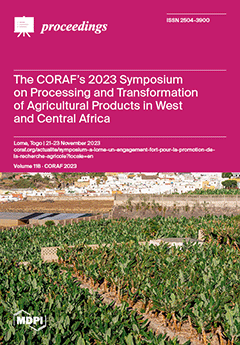Need Help?
Proceedings, 2025, CORAF 2023
The CORAF’s 2023 Symposium on Processing and Transformation of Agricultural Products in West and Central Africa
Lome, Togo | 21–23 November 2023
Volume Editors:
G. Esaïe Kpadonou, CORAF, Senegal
Kyky Komla Ganyo, CORAF, Senegal
Ayoni Ogunbayo, CORAF, Senegal
Emmanuel Njukwe, CORAF, Senegal
Niéyidouba Lamien, CORAF, Senegal
Aissatou Drame Yaye, Université Abdou Moumouni, Niger
Printed Edition Available!
- Issues are regarded as officially published after their release is announced to the table of contents alert mailing list.
- You may sign up for e-mail alerts to receive table of contents of newly released issues.
- PDF is the official format for papers published in both, html and pdf forms. To view the papers in pdf format, click on the "PDF Full-text" link, and use the free Adobe Reader to open them.
Cover Story (view full-size image):
CORAF organized an international symposium from 21st to 23rd November 2023, in Lomé, Togo. It provided a unique opportunity for plant breeders, researchers, students, private companies,
[...] Read more.
CORAF organized an international symposium from 21st to 23rd November 2023, in Lomé, Togo. It provided a unique opportunity for plant breeders, researchers, students, private companies, national agricultural research systems, and policymakers to discuss their findings, share their achievements, and forge new partnerships. These interactions are the seeds from which future innovations will grow, paving the way for a more prosperous and resilient agricultural sector in the West and Central Africa region and beyond. The symposium’s outcomes and discussions, presented in this Proceedings volume, reflect the commitment of CORAF to advancing agriculture in the region, addressing contemporary challenges, and fostering innovative solutions for the benefit of West and Central Africa.
Previous Issue
Next Issue
Issue View Metrics
Multiple requests from the same IP address are counted as one view.



